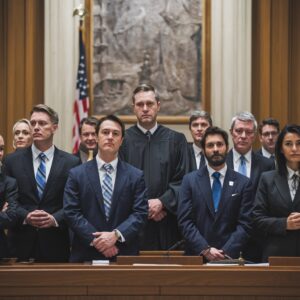
As a professional in the legal field, I’m always fascinated by how lawyers can use their expertise to make connections outside of the courtroom. One interesting aspect of this is the world of law chat-up lines. These clever and witty phrases are used by lawyers to impress potential romantic interests with their knowledge of the law and courtroom terminology. It’s a unique way for legal professionals to showcase their personality and humor while making a lasting impression.
Law chat-up lines are filled with puns and wordplay that play on legal jargon. For example, you might hear a lawyer say, “If I were a judge and you were on trial, I’d have to find you guilty of stealing my heart.” Or perhaps, “Do you have a privacy policy? Because I’d like to know if I have the right to remain silent.” These lines not only showcase a lawyer’s knowledge of the law, but also their wit and cleverness.
Key Takeaways:
- Law chat-up lines are clever phrases used by lawyers to impress potential romantic interests.
- These lines make use of legal jargon and courtroom terminology to showcase a lawyer’s knowledge.
- Lawyer pick-up lines allow legal professionals to showcase their personality and sense of humor while making a lasting impression.
- These lines often involve puns and wordplay that play on legal concepts and terminology.
- Law chat-up lines are a unique way for lawyers to connect with others outside of the courtroom.
The Art of Flirting: Understanding Consent
In the world of flirting, consent is a crucial and fundamental aspect that should never be overlooked. Consent is an agreement between individuals to engage in sexual activity, and it must be freely and clearly communicated by all parties involved.
Consent goes beyond a simple “yes” or “no”; it is an ongoing process that requires open and honest communication about boundaries, comfort levels, and desires. It is essential to have conversations with your partner about what you are comfortable with and what you are not. This ensures that both individuals involved feel respected and safe throughout any sexual interaction.
It’s important to note that consent cannot be given by individuals who are underage, intoxicated, incapacitated, or under any form of pressure. Everyone involved should be able to give enthusiastic consent, which is a positive expression of consent. Enthusiastic consent focuses on actively looking for the presence of a “yes” rather than the absence of a “no.”
Open communication is key when it comes to enthusiastic consent. Regularly checking in with your partner and ensuring their comfort level is crucial. Respect their boundaries and be attentive to any verbal or nonverbal cues that indicate their consent or lack thereof.
Verbal Consent
Verbal consent involves the explicit communication of consent using words. It can be as simple as asking, “Is this okay?” or saying, “I want to make sure you’re comfortable.” Verbal consent leaves no room for ambiguity, ensuring that both individuals are on the same page.
Nonverbal Cues
Nonverbal cues can also play a role in understanding consent. However, it’s important to remember that they should supplement verbal communication, not replace it. Some individuals may find it challenging to express their boundaries verbally, so paying close attention to their nonverbal cues can help create a more comfortable environment. However, nonverbal cues should never be assumed or relied upon solely.
Enthusiastic consent emphasizes open communication, checking in with your partner, and respecting their boundaries.
Communicating Boundaries
When engaging in any form of sexual activity, it’s important to establish and communicate boundaries. This can be done through open and honest conversations with your partner. Discuss what you are comfortable with, what you are not, and any limits you may have. Respecting each other’s boundaries and ensuring that these boundaries are constantly acknowledged and upheld is crucial for a healthy and consensual interaction.
| Key Points | Actions |
|---|---|
| 1. Consent is an ongoing process that requires communication. | Create a safe space for open conversations about boundaries and comfort levels. |
| 2. Enthusiastic consent focuses on positive expressions of consent. | Regularly check in with your partner and ensure their comfort. |
| 3. Verbal consent ensures clear and unambiguous communication. | Ask for explicit consent and listen for a verbal affirmation. |
| 4. Nonverbal cues should supplement verbal consent, not replace it. | Pay attention to your partner’s nonverbal cues, but always seek verbal confirmation. |
| 5. Communicate and respect boundaries. | Have open and honest conversations about boundaries and limits. |
Where and When to Flirt: Establishing Boundaries
Flirting is a socially acceptable and often expected behavior in various settings. Understanding the appropriate boundaries and contexts for flirting can help ensure respectful and enjoyable interactions. Here are some common flirting settings:
Parties and Celebrations
Parties and celebratory events provide a relaxed and social atmosphere that encourages flirting. Whether it’s a birthday party, wedding, or holiday gathering, these settings offer opportunities to connect with others and express interest in a romantic or playful way.
Drinking-Places: Bars and Nightclubs
Bars and nightclubs are popular venues for flirting, as the social environment and alcohol consumption create a more relaxed atmosphere. However, it’s important to be mindful of boundaries and respectful of others’ space and consent, especially in potentially crowded or noisy environments.
Learning-Places: Schools and Colleges
Schools and colleges often foster a sense of community and camaraderie among students, making them hotbeds for flirting. Shared interests and a relaxed academic environment can naturally lead to connections and romantic sparks. However, it’s crucial to respect personal boundaries, maintain a professional approach in educational settings, and ensure that all interactions are consensual.
The Workplace
The workplace has its own dynamics and unspoken rules when it comes to flirtatious behavior. While some degree of banter and light-heartedness can be acceptable, it’s essential to be cautious and considerate of power dynamics, professionalism, and company policies. Always prioritize creating a respectful and comfortable work environment for yourself and your colleagues.
Participant Sports and Hobbies
Engaging in sports or hobbies that involve teamwork or competition can naturally lead to flirtatious interactions. The level of flirtatious behavior can vary depending on the participants’ comfort levels and the nature of the activity. It’s important to be aware of others’ boundaries and communicate openly to ensure that everyone feels comfortable and included.
Spectator Events
Spectator events, such as sports games or theater performances, are not typically conducive to flirting. These settings are focused on the activity itself, and participants are often invested in the event rather than seeking romantic connections. It is best to enjoy the event and respect the atmosphere without attempting to engage in flirtatious behavior.
Establishing boundaries in flirting settings is crucial to ensure that interactions are consensual, respectful, and enjoyable for everyone involved. Being aware of the appropriate contexts for flirting and understanding others’ comfort levels are key to fostering positive connections and avoiding misunderstandings.
Conclusion
In conclusion, legal flirting etiquette calls for respect and adherence to boundaries. It is crucial to communicate openly and obtain explicit consent before engaging in any sexual activity, ensuring enthusiastic consent rather than assuming it based on the absence of a “no.” Understanding nonverbal cues can complement verbal communication, but it is essential to seek verbal confirmation for consent.
Respecting boundaries is key to maintaining healthy and enjoyable flirting experiences. This involves being aware of the appropriate settings for flirting, such as parties, drinking-places, and learning-places, where social interactions are expected and welcomed. By understanding these contexts, individuals can establish clear boundaries and prevent misunderstandings.
By practicing enthusiastic consent, individuals prioritize the presence of affirmative and genuine consent from their partners. This includes checking in regularly, actively listening, and being mindful of their comfort levels. Adhering to legal flirting etiquette ensures that flirting experiences are not only enjoyable but also respectful and consensual.
FAQ
What are lawyer pick-up lines?
Lawyer pick-up lines are witty and pun-filled phrases used by lawyers to impress potential romantic interests. These one-liners often make clever use of legal jargon and courtroom terminology.
Can you give me some examples of lawyer pick-up lines?
Sure! Here are a couple of classic examples: “If I were a judge and you were on trial, I’d have to find you guilty of stealing my heart” and “Do you have a privacy policy? Because I’d like to know if I have the right to remain silent.”
What is consent?
Consent is an agreement between participants to engage in sexual activity and should be clearly and freely communicated. It is an ongoing process that requires discussion about boundaries and comfort levels.
Who can give consent?
Consent cannot be given by individuals who are underage, intoxicated, incapacitated, or under pressure.
What is enthusiastic consent?
Enthusiastic consent is a concept that focuses on positive expressions of consent, looking for the presence of a “yes” rather than the absence of a “no.” It involves open communication, checking in with your partner, and respecting their boundaries.
Where are some appropriate settings for flirting?
Parties, drinking-places like bars and nightclubs, learning-places such as schools and colleges, and participant sports and hobbies can all be conducive to flirting due to shared interests and relaxed atmospheres.
Is flirting acceptable in the workplace?
Flirting in the workplace has its own unwritten etiquette, and it’s important to be aware of and respect these boundaries.
Are spectator events good places for flirting?
Spectator events like sports games or theater performances are not typically conducive to flirting due to the focus on the activity itself.









